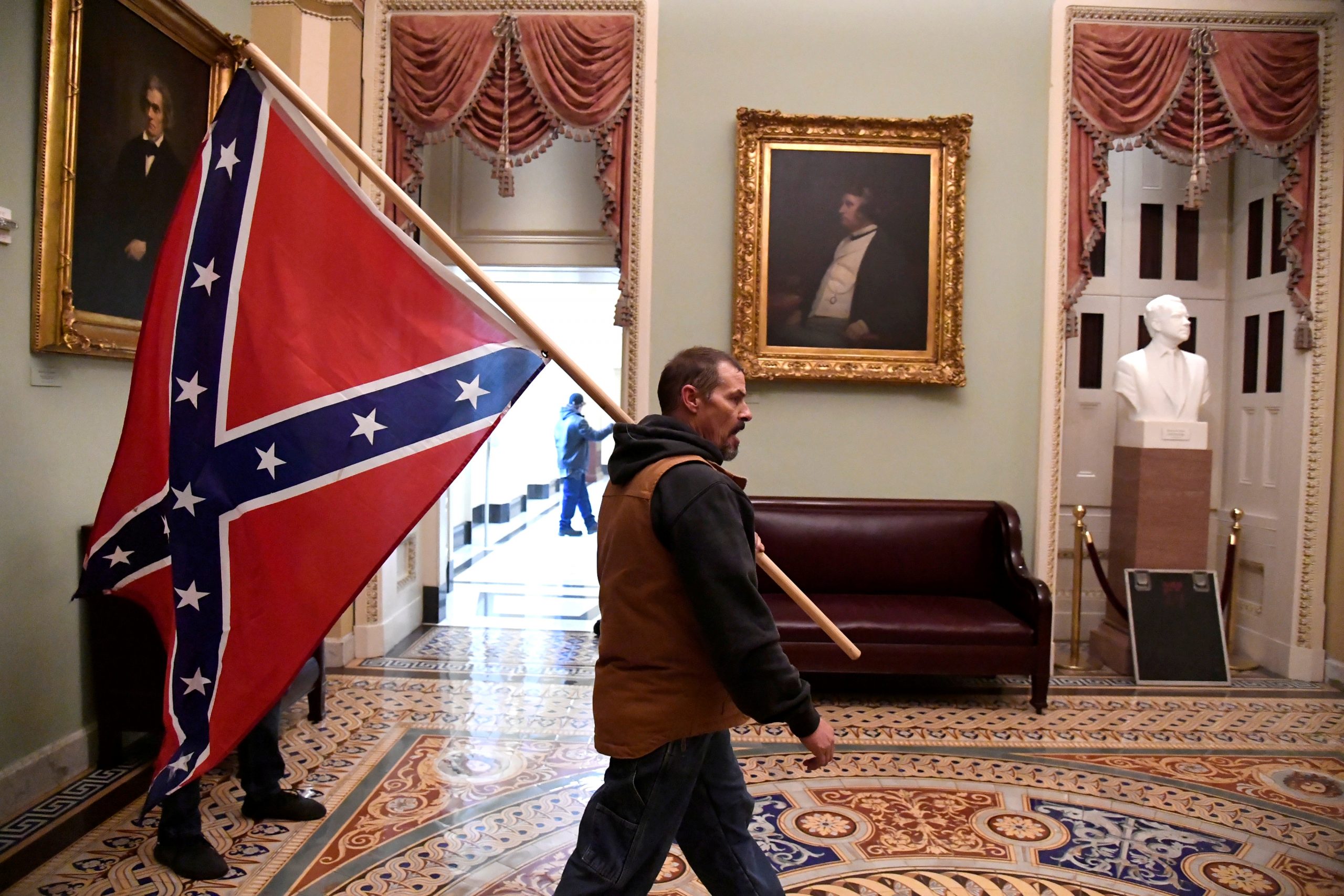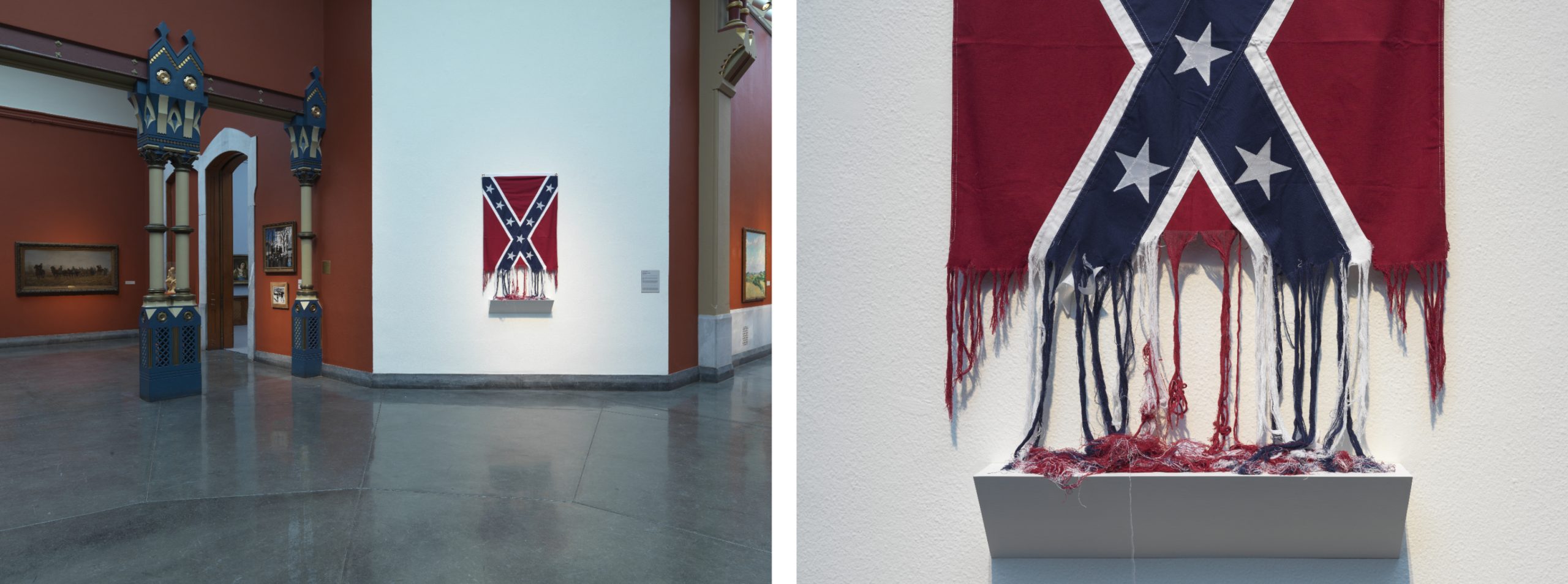The Confederate Flag in the Capitol and the Future of Artistic Expression
On January 6, 2021, I was working on an art censorship curriculum for the website First Amendment Watch and took a break to watch the electoral count. My feeling of calm at witnessing the usual transfer of power segued rapidly to screaming at the television. After more than a year of watching the brutal suppression of Black Lives Matter protests, the kid-glove treatment of the US Capitol mob filled me with rage and shame on behalf of my country.
From my intellectual perch, deeply immersed in our law and culture of free expression, I also immediately realized that lawmakers in the Capitol now would be forced to finally reckon with a question decades in the making: Can America survive its libertarian approach to free expression? And, if the answer is no, then what are the implications for our artistic expression in the future? One photograph in particular underscored the significance of these questions.

On the afternoon of January 6, Reuters photographer Mike Theiler captured an image of Kevin Seefried carrying a Confederate Battle flag through an anteroom linking the Old and New Senate chambers (fig. 1). Among the many tragedies of that day, Black legislators and congressional aides told the New York Times that their “feelings of safety” at work had crumbled. An aide to Senator Elizabeth Warren, Josh Delaney, who is Black and grew up in Georgia, reported that the Confederate flag was a “painful but commonplace reminder of where he was not welcome. . . . I have always felt like [the Capitol] is the safest place I could be . . . to have that illusion shattered, I don’t know that I’ll ever have that same feeling again.”1
Ideally, given what the Confederate Battle Flag symbolizes, every American should be traumatized by the sight of this flag in the US Capitol. The particular version carried by Seefried is the iteration of the Confederate flag that accompanied the most violent acts of insurrectionists on behalf of preserving white Americans’ so-called “state’s rights” to hold African Americans in the legal status of chattel, or personal property. The power of Theiler’s photo of Seefried is intensified when we notice that it also contains a portrait of one of the loudest supporters of slavery, South Carolina Senator John C. Calhoun, pictured just behind the flag to the left, and, on the right, a bust of Richard Nixon.
In a remarkable twist of fate, Theiler photographed Seefried just as he was about to pass beneath the third portrait in the scene, at center. Painted by Walter Ingalls, this side profile depicts Massachusetts Senator Charles Sumner, a Radical Republican who joined with his close friend Frederick Douglass to lead the call for abolition. Sumner’s courage and passion, like Douglass’s, are legendary. Following a particularly fiery speech in support of abolition in 1856, Sumner was attacked and nearly killed on the floor of the Senate by Preston Brooks, a proslavery representative from South Carolina.
Only after three years of physical recovery from his wounds, and four years of bloody Civil War, was Sumner able to successfully shepherd passage of the Thirteenth, Fourteenth, and Fifteenth Amendments to the US Constitution through the legislature, legally ending slavery and providing an aspirational path forward toward full citizenship for all Americans.
Seen through the lens of law, Theiler’s photograph presents us with a stark contrast—Sumner the victim, and Seefried the perpetrator. Brooks, the congressman who beat Sumner nearly to death, was arrested and ultimately fined for the crime of assault. Seefried and his son, who accompanied him, also were charged in federal court and could collectively spend a decade in prison and be subject to $250,000 in fines for their unlawful entry, “disorderly conduct,” and “depredation of government property.”2
They will not, however, be charged for carrying the nation’s most potent symbol of white nationalism, white supremacy, and chattel slavery into the Capitol. By doing so, they effectively created a hostile workplace environment for Black staffers and legislators, and they traumatized millions of Americans who saw that symbol in the Capitol and understood its full intentions and ramifications. Nevertheless, the Supreme Court has ruled that flags are symbolic speech and are therefore protected under the First Amendment of the US Constitution. This stands in stark contrast to legal standards in most of the world. For example, if Seefried was charged in Germany or Austria for display of a Nazi flag in similar circumstances, he would face three years in prison for that crime alone.3 Most nations recognize the power of symbols and speech to cause psychic trauma, political destabilization, and violence.
Our American tradition of free speech emerged from colonial outrage that dissent against the Crown had been suppressed, as well as a belief, arising during the Enlightenment, that vibrant expression promotes pluralism and fuels creative and intellectual achievements. In light of those principles, First Amendment jurisprudence since the mid-twentieth century largely has hewed to the concept of content and viewpoint neutrality, under the implicit assumption that weakening Seefried’s right to fly the Confederate flag outside his home could weaken someone else’s right to fly a Black Lives Matter or LGBTQIA Pride flag.
The tragic events of January 6, require us to consider this disturbing question: To what extent did our extraordinary right to free expression ultimately enable and empower those who came so close to ending our democracy? Investigation is likely to reveal that Seefried read endless streams of misinformation about the election disseminated on social media platforms owned by private American corporations, and then received instructions on those same platforms as to when and where to go to #StoptheSteal. There is currently no provision in United States law to hold social media companies civilly or criminally liable for their facilitation of what ultimately became deadly insurrection.
Although the First Amendment only prohibits the government’s ability to restrict freedom of speech, the ideal of content and viewpoint neutrality is woven into our culture and our expectations of what we can say and do on privately owned communication platforms. The United States is home to the world’s largest search engines and social media platforms in large part because of the safe harbor they have been given under federal law by Section 230 of the Communications Decency Act of 1996 (47 U.S.C. § 230). Under the terms of that provision, Facebook, Twitter, Google, Instagram, and other online platforms are treated as mere conduits of information, with no liability for harm resulting from the communication that flows on their sites.
The assumption of content and viewpoint neutrality that drove the adoption of Section 230 has been proven false. Even if online services were “mere conduits” when first launched, the law has been overtaken by technological developments and social circumstances. In recent years, these sites have actively amplified increasingly radical speech because it provokes more views and engagement than rational speech, and it therefore generates more advertising revenue. Today, it would be impossible to argue that these companies are neutral.
On January 6, the dangers and fictions of these free speech arrangements were translated into real-world destruction and death. Shortly after the riots, any remaining pretense that social media sites were mere conduits of speech evaporated. Twitter, Facebook, and other platforms blocked Donald Trump entirely, QAnon sites went dark, and Amazon dropped Parler from its hosting service, all of which thankfully crippled, at least temporarily, the ability of insurrectionist groups to communicate among themselves. Overnight, the ecosystem of American speech was restricted at a speed and scope unimaginable on January 5. Transformative changes in communications law now seem inevitable.
Most Americans likely will see increased government regulation of search engines and social media platforms as necessary and even welcome after the Capitol riots. However, artists, curators, and art audiences should not be naive about the threats that will inevitably accompany dramatic shifts in American communications law and our traditional cultural embrace of free speech. Sometimes, harmful images are the only way to see the truth.
Removing harmful expression from social media sites mostly involves moderation by algorithms triggered by specific phrases and images. These algorithms could easily be set to erase posts with the Confederate flag, in which case the psychic harm of seeing this image would be significantly diminished; however, Theiler’s photograph of Seefried also would be purged from our view. An army of human moderators might be able to distinguish some nuances of context and purpose, but the power of political and/or corporate individuals and organizations to police expression is dangerous. Already, an enormous volume of art is removed from social media platforms by triggered algorithms, with little reason or recourse.

Consider, for example, the powerful work Unraveling (fig. 2) by the artist Sonya Clark, the result of a performance the artist has repeated in galleries and museums across the country. In a video posted by the gallery Mixed Greens in 2015, we see Clark as she works with audience members to literally unravel a Confederate battle flag. Through the graceful actions of the artist and participants, the harmful image of the flag becomes a site for neighbors to work together to deconstruct racism. It would be wonderful if Clark could perform Unraveling with Capitol staff and elected officials at their workplace as a form of catharsis. And it would then be important for this reparative image to be shared as widely as possible, to symbolize the work we can and must do to deconstruct the harmful legacies of enslavement and structural racism. New legislation banning hate speech and the use of algorithms to control internet content would render Clark’s work invisible. More symbolic expression—art—rather than less expression, should be at the forefront of our efforts.
The photographs of January 6, 2021, demonstrate the power of harmful images to terrorize, but they also revealed America as it really is, and with that revelation comes the possibility of seeing and stitching up our deep wounds.
Cite this article: Amy Werbel, “The Confederate Flag in the Capitol and the Future of Artistic Expression,” in Art and Politics in the US Capitol, special section, Panorama: Journal of the Association of Historians of American Art 7, no. 1 (Spring 2021), https://doi.org/10.24926/24716839.11749.
PDF: Werbel, The Confederate Flag in the Capitol
Notes
- Maria Cramer, “Confederate Flag an Unnerving Sight in Capitol,” New York Times, January 9, 2021. ↵
- United States Department of Justice, “Two Delaware Men Charged in Federal Court Following Events at the United States Capitol” (news release), January 14, 2021, https://www.justice.gov/usao-dc/pr/two-delaware-men-charged-federal-court-following-events-united-states-capitol. ↵
- Maria Bierbach and Karsten Kaminski, “Germany’s Confusing Rules on Swastikas and Nazi Symbols,” Deutsche Welle, August 14, 2018, https://www.dw.com/en/germanys-confusing-rules-on-swastikas-and-nazi-symbols/a-45063547. ↵
About the Author(s): Amy Werbel is Professor of the History of Art, State University of New York-Fashion Institute of Technology. She is a Book Reviews editor at Panorama.

